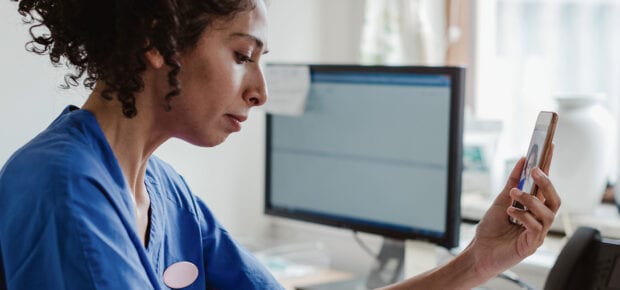October 26, 2020
Telehealth, often referred to as virtual doctor appointments, has been utilized in remote regions that do not have local medical resources for several decades. But when COVID-19 began impacting many countries across the globe, telehealth became the go-to method for checking in with your doctor about possible COVID-19 symptoms or other healthcare check-ups.
“Telehealth has been around for quite some time, pre-internet it was literally done by telephone, usually for patients in remote locations or those that couldn’t travel,” says IEEE Member Todd Richmond. “Pre-COVID-19, technologies like videoconferencing were nice-to-haves, and most organizations had them as a fairly low priority. COVID-19 and physical distancing moved the capability from option to necessity.”
A priority was not placed on telehealth until the pandemic gave us no other option but to expand this resource.
“For many years telehealth/medicine was in a waiting mode, talked about, but not available as both the technology (bandwidth, computing power, cameras) and the users’ (doctors and patients) interest were not there,” says IEEE Senior Member Paul Kostek.
“We’ve probably had more improvements in videoconferencing software in the last six months than we had in the last two decades,” adds Richmond. “Necessity is the mother of invention (or at least videoconference features).”
Another benefit of telehealth is having the ability to connect with an online chatbot that can “analyze” your symptoms and help decide if a virtual or in-person visit is necessary . Chatbots can help reduce the number of people in hospital emergency waiting rooms and limit contact with potential virus sources.
“Telehealth has helped to improve patient care by incorporating machine learning to decide on the most appropriate delivery of care,” says IEEE Member Kayne McGladrey. “For patients, this has reduced the amount of time spent in triage and helped patients decide on the best course of action, from staying home for a virtual visit with a nurse to going to an urgent care facility.”
How are Technologists Protecting Our Virtual Health Data?
Any device or software that uses the internet to connect means there are cybersecurity risks involved. It is crucial that private health data remain protected.
One of the biggest concerns associated with telehealth is how to keep the data of the patients protected and avoiding hackers that can steal the patients’ data, explains IEEE Senior Member Marcio Andrey Teixeira. “Solutions like authentication improvement are being developed to mitigate hacker attacks.”
Two-factor authentication, a protection where the user must provide two forms of identification before accessing their records, is now becoming standard operating procedure in the healthcare industry. Biometric identification, a protection where the user unlocks their information through a biological characteristic such as a fingerprint or through voice-control, is being utilized in some instances as well.
“Blockchain technologies hold the promise of increasing security but there is still a lot of work to be done,” says Richmond. “In the meantime, encryption and hardening networks continue behind the scenes to try and keep data safe, — particularly health data due to the sensitive nature.”
Encryption converts sensitive data into codes or symbols if intercepted by an unwanted party. Encryption is often used in emails and when sharing financial data through the internet.
“As telehealth is driving exponential data growth, providers should also be wary of unwanted exfiltration and encryption of their patient data via ransomware, and use threat hunting where feasible to find and evict threat actors before they can cause a material breach,” says McGladrey.
What is the Future of Telehealth?
Telehealth has the potential to provide higher quality healthcare for more patients and will only continue to grow now that we are seeing the benefits of using this technology to reduce exposure to germs and viruses that could occur through in-person healthcare.
“I think this will become the norm, saving time for patients, especially those living in rural areas and older patients for whom getting to the doctor may be a challenge, while also providing medical providers with more efficient use of their time and the ability to focus their face time on patients with serious conditions,” says Kostek. “This will also allow doctors to collaborate with other doctors in remote locations and examine or diagnose patients.”
Another future potential and benefit of telehealth is the ability to receive and give results and diagnostics faster and more efficiently.
“The fact that these tools are so readily available is going to make it a lot easier for the physiological monitoring since a lot of these tests can now be done remotely,” says IEEE Senior Member Paolo Bonato, also a member of the IEEE Engineering in Medicine and Biology Society.
Imagine a doctor just waiting at their desk doing other tasks and when they see that the test is ready, they talk to the patient immediately. Once they have finished delivering the results, they can go back to their other work.
“We’re going to see a significant increase in the use of our tools this way,” says Bonato.
“Ultimately, telehealth changes healthcare for the better,” adds McGladrey. “And in the case of global pandemics, related technologies such as virtual rounding can reduce risks of infection to healthcare providers by giving quarantined patients in hospitals a dedicated device for real-time videoconferencing and monitoring.”
Interested in learning more about telehealth and telemedicine’s impact on COVID-19? The Virtual IEEE EMBS Forum on Advancing Technologies for COVID19 Screening, Tracking and Treatment will be held on November 12 – 15. The forum aims to highlight and discuss the challenges and opportunities in advancing technologies for COVID-19 screening, tracking, and treatment.





 AI Through Our Ages
AI Through Our Ages Liquid Infrastructure: Our Planet's Most Precious Resource
Liquid Infrastructure: Our Planet's Most Precious Resource The Impact of Technology in 2025
The Impact of Technology in 2025 Quantum and AI: Safeguards or Threats to Cybersecurity?
Quantum and AI: Safeguards or Threats to Cybersecurity? Why AI Can't Live Without Us
Why AI Can't Live Without Us Bits, Bytes, Buildings and Bridges: Digital-Driven Infrastructure
Bits, Bytes, Buildings and Bridges: Digital-Driven Infrastructure Impact of Technology in 2024
Impact of Technology in 2024 Emerging AI Cybersecurity Challenges and Solutions
Emerging AI Cybersecurity Challenges and Solutions The Skies are Unlimited
The Skies are Unlimited Smart Cities 2030: How Tech is Reshaping Urbanscapes
Smart Cities 2030: How Tech is Reshaping Urbanscapes Impact of Technology 2023
Impact of Technology 2023 Cybersecurity for Life-Changing Innovations
Cybersecurity for Life-Changing Innovations Smarter Wearables Healthier Life
Smarter Wearables Healthier Life Infrastructure In Motion
Infrastructure In Motion The Impact of Tech in 2022 and Beyond
The Impact of Tech in 2022 and Beyond Cybersecurity, Technology and Protecting Our World
Cybersecurity, Technology and Protecting Our World How Technology Helps us Understand Our Health and Wellness
How Technology Helps us Understand Our Health and Wellness The Resilience of Humanity
The Resilience of Humanity Harnessing and Sustaining our Natural Resources
Harnessing and Sustaining our Natural Resources Creating Healthy Spaces Through Technology
Creating Healthy Spaces Through Technology Exceptional Infrastructure Challenges, Technology and Humanity
Exceptional Infrastructure Challenges, Technology and Humanity The Global Impact of IEEE's 802 Standards
The Global Impact of IEEE's 802 Standards Scenes of our Cyber Lives: The Security Threats and Technology Solutions Protecting Us
Scenes of our Cyber Lives: The Security Threats and Technology Solutions Protecting Us How Millennial Parents are Embracing Health and Wellness Technologies for Their Generation Alpha Kids
How Millennial Parents are Embracing Health and Wellness Technologies for Their Generation Alpha Kids Space Exploration, Technology and Our Lives
Space Exploration, Technology and Our Lives Global Innovation and the Environment
Global Innovation and the Environment How Technology, Privacy and Security are Changing Each Other (And Us)
How Technology, Privacy and Security are Changing Each Other (And Us) Find us in booth 31506, LVCC South Hall 3 and experience the Technology Moon Walk
Find us in booth 31506, LVCC South Hall 3 and experience the Technology Moon Walk Virtual and Mixed Reality
Virtual and Mixed Reality How Robots are Improving our Health
How Robots are Improving our Health IEEE Experts and the Robots They are Teaching
IEEE Experts and the Robots They are Teaching See how millennial parents around the world see AI impacting the lives of their tech-infused offspring
See how millennial parents around the world see AI impacting the lives of their tech-infused offspring Take the journey from farm to table and learn how IoT will help us reach the rising demand for food production
Take the journey from farm to table and learn how IoT will help us reach the rising demand for food production Watch technical experts discuss the latest cyber threats
Watch technical experts discuss the latest cyber threats Explore how researchers, teachers, explorers, healthcare and medical professionals use immersive technologies
Explore how researchers, teachers, explorers, healthcare and medical professionals use immersive technologies Follow the timeline to see how Generation AI will be impacted by technology
Follow the timeline to see how Generation AI will be impacted by technology Learn how your IoT data can be used by experiencing a day in a connected life
Learn how your IoT data can be used by experiencing a day in a connected life Listen to technical experts discuss the biggest security threats today
Listen to technical experts discuss the biggest security threats today See how tech has influenced and evolved with the Games
See how tech has influenced and evolved with the Games Enter our virtual home to explore the IoT (Internet of Things) technologies
Enter our virtual home to explore the IoT (Internet of Things) technologies Explore an interactive map showcasing exciting innovations in robotics
Explore an interactive map showcasing exciting innovations in robotics Interactively explore A.I. in recent Hollywood movies
Interactively explore A.I. in recent Hollywood movies Get immersed in technologies that will improve patients' lives
Get immersed in technologies that will improve patients' lives